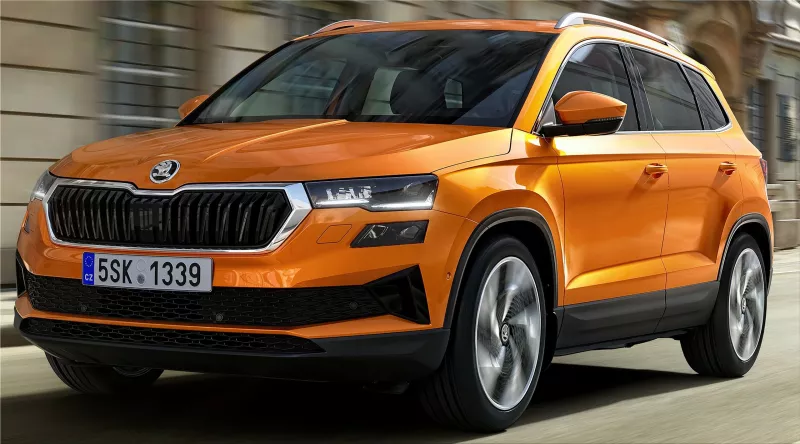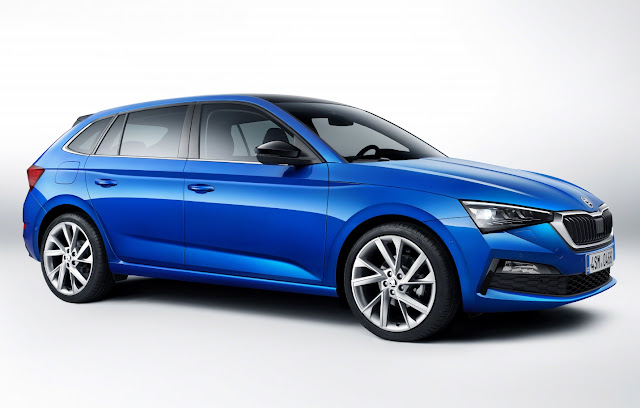Skoda KAROQ and Skoda SCALA are recognized as residual value giants
Two victories and further podium places for Skoda in the residual value forecast from Focus Online and Bähr & Fess Forecasts.
Skoda KAROQ 1.0 TSI 81 kW (110 PS) (combined fuel consumption 5.5 - 5.2 l / 100 km, combined CO2 emissions 125 - 118 g / km) wins with the best absolute residual value among medium-sized SUVs.
Skoda SCALA 1.0 TSI 70 kW (95 PS) (combined fuel consumption 4.7 - 4.7 l / 100 km, combined CO2 emissions 108 - 106 g / km) retains most of its value of all compact cars considered.
Two models from Skoda are listed in the renowned semi-annual residual value forecast by Focus Online and Bähr & Fess Forecasts in first place for residual value in euros. Furthermore, after four years, no other vehicle in its segment retains as much of its new value as the Skoda KAROQ 1.0 TSI 81 kW (110 hp) and Skoda SCALA 1.0 TSI with 70 kW (95 hp).
Every six months, Focus Online and the market experts from Bähr & Fess Forecasts create forecasts of the residual value of current models after 48 months of use. Therefore, the current estimates relate to a new vehicle bought in December 2021 and sold again in December 2025.
As absolute residual value giants, Focus Online and Bähr & Fess Forecasts distinguish those models that have lost the least amount of value in euros by 2025. In the current forecast, the Skoda KAROQ 1.0 TSI 81 kW (110 hp) wins this title in the medium SUV category. Skoda recently completely revised the compact model family, consistently developed the design language, and further upgraded the KAROQ with sustainable materials, new technologies, and more efficient engines from the current EVO generation.
With the SCALA 1.0 TSI 70 kW (95 hp), Skoda also provides the absolute residual value giant in 2025 in the compact car category. Skoda has completely redefined its compact class in the current generation of models. Modern technology, inspirational design, high functionality, and state-of-the-art connectivity set standards in this segment.
Two other Skoda models make it onto the podium thanks to their above-average value retention. In the small car category, the Skoda FABIA 1.0 MPI achieves 48 kW (66 hp) (combined fuel consumption 4.6 - 4.4 l / 100 km, CO2 Emissions combined 106 - 101 g / km) as well as second place as the Skoda SUPERB COMBI 1.5 TSI ACT 110 kW (150 hp) (combined fuel consumption 5.4 - 5.2 l / 100 km, combined CO2 emissions 124 - 119 g / km) in the middle class.
In another evaluation, Focus Online and Bähr & Fess Forecasts calculate which vehicles show the lowest percentage loss in value compared to their new price. Here, the Skoda KODIAQ 1.5 TSI ACT 110 kW (150 hp) (combined fuel consumption 6.1 - 5.6 l / 100 km, combined CO2 emissions 138 - 129 g / km) takes a top position. According to the forecast, it achieves a top position variant after 48 months, a remarkable 57 percent of the underlying new price of 30,000 euros - the second-best value of all medium-sized SUVs.

According to the legally prescribed measuring procedures, the stated consumption and emission values were determined. However, since September 1, 2017, certain new vehicles have been type-approved by the Worldwide Harmonized Light Vehicles Test Procedure (WLTP), a more realistic test procedure for measuring fuel consumption and CO2 emissions. Since September 1, 2018, the new WLTP (Worldwide Harmonized Light Vehicles Test Procedure) has replaced the previous driving cycle (NEDC). Due to the more realistic test conditions, the fuel consumption and CO2 emission values measured according to the WLTP are in many cases higher than those measured according to the NEDC. For more information on the differences between WLTP and NEDC, seewww.skoda-auto.de/wltp.
Currently, the NEDC values are still mandatory to communicate. As far as new cars are concerned that are type-approved according to WLTP, the NEDC values are derived from the WLTP values. The additional specification of the WLTP values can be registered voluntarily until they are used. Insofar as the NEDC values are given as ranges, they do not refer to a single, individual vehicle and are not part of the offer. They are used solely for purposes of comparison between the various vehicle types. Additional equipment and accessories (attachments, tire format, etc.) can include relevant vehicle parameters, such as B. change weight, rolling resistance and aerodynamics, weather and traffic conditions, and individual driving behavior, fuel consumption, and electricity consumption.
Further information on the official fuel consumption and the specific CO2 emissions of new passenger vehicles can be found in the "Guide to fuel consumption, CO2 emissions and power consumption of new passenger vehicles", which is available at all sales outlets and DAT Deutsche Automobil Treuhand GmbH.





